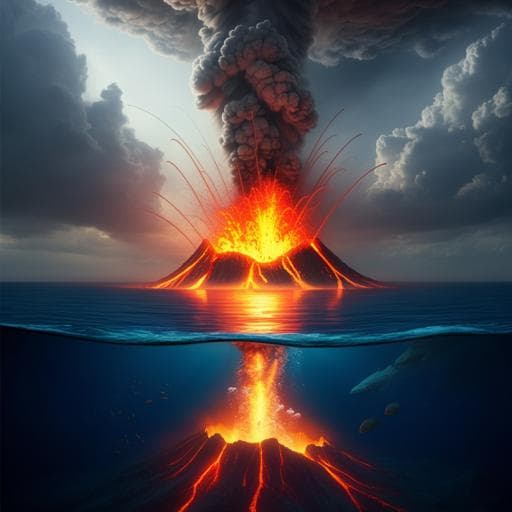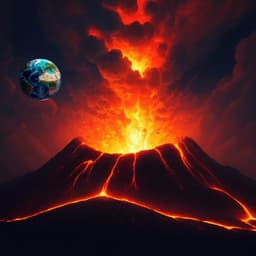
Earth Sciences
The unexpected radiative impact of the Hunga Tonga eruption of 15th January 2022
P. Sellitto, A. Podglajen, et al.
Explore the groundbreaking findings from P. Sellitto and colleagues, who investigated the vast impacts of the January 2022 Hunga Tonga-Hunga Ha'apai volcanic eruption on our climate, including the largest stratospheric aerosol perturbation since 1991 and significant radiative effects in the atmosphere.
~3 min • Beginner • English
Introduction
Major volcanic eruptions can inject gases and aerosols into the stratosphere, altering radiative balance and climate. The 15 January 2022 Hunga Tonga-Hunga Ha’apai (HT) eruption produced an exceptionally high plume (>50 km). Despite satellite-derived SO2 burden estimates of only about 0.4–0.5 Tg (much less than Pinatubo 1991 or Raikoke 2019), early assessments suggested negligible climate impact. This study asks: did the HT eruption nevertheless produce strong stratospheric aerosol and water vapour perturbations, and what were their short-term radiative and dynamical impacts? The purpose is to quantify the relative radiative impacts of sulfate aerosols versus water vapour during the initial weeks after the eruption using a synthesis of multi-platform observations and offline radiative transfer modelling, and to interpret how these perturbations influenced plume evolution and climate forcing.
Literature Review
Background observations and prior studies indicate large eruptions (e.g., El Chichón 1982, Pinatubo 1991) can strongly perturb the stratosphere via SO2-to-sulfate aerosol formation and radiative forcing. Recent events like Raikoke 2019 and the 2019–2020 Australian fires also enhanced stratospheric aerosol optical depth (SAOD). For HT, reported SO2 burdens (~0.4–0.5 Tg) were modest compared to Pinatubo (14–23 Tg) or Raikoke (~1.5 Tg), leading to expectations of minor aerosol/climate impact. However, rapid SO2-to-sulfate conversion can be accelerated by high humidity; HT injected unprecedented stratospheric water vapour (estimated >100 Tg), potentially altering aerosol formation and radiative effects. Previous records showed Australian fires as the largest SAOD perturbation since Pinatubo, but this work reevaluates that in light of HT.
Methodology
The study synthesizes multiple observation systems and performs offline radiative transfer (RT) modelling: (1) Geostationary Himawari-8 Ash RGB product to track early plume evolution and qualitatively distinguish ash/ice versus sulfur-containing plumes using 8.5, 10.4, and 12.3 µm channels. (2) IMS/IASI optimal estimation retrievals for SO2 (1100–1200 cm−1) and sulfate-specific AOD (~1200 cm−1), with sulfate mass burden estimated using assumed mid-IR mass extinction efficiency (0.15–0.4 m2 g−1) after subtracting a pre-eruption baseline. (3) CALIPSO-CALIOP spaceborne lidar (532 nm) to derive attenuated backscatter, depolarization, AOD, lidar ratios, and aerosol extinction profiles; track vertical distribution and microphysics (sphericity). (4) OMPS-LP limb profiler (675 nm) aerosol extinction and integrated SAOD time series; historical comparison via GloSSAC. (5) Ground-based AERONET sun photometers to assess fine/coarse mode AOD and single-scattering albedo during plume overpasses in Australia and La Réunion. (6) In situ LOAC balloon-borne optical particle counter at La Réunion for size distributions and extinction, identifying submicron liquid aerosols at ~22–25 km. (7) Radiosonde water vapour profiles (Vaisala RS41) in Western Australia and Saint Helena, with anomaly method to mitigate outgassing, showing record stratospheric humidities. (8) RT modelling with libRadtran/UVSPEC under clear-sky, equinox-equivalent daily-average conditions, AFGL tropical standard atmosphere. Cases: fresh plume higher and lower sections (from CALIOP 16 Jan) and aged plume after one circumnavigation (8 Feb), with corresponding radiosonde water vapour profiles (Australia 19–20 Jan; Australia 8 Feb) and an additional water vapour case over the southern Atlantic (Saint Helena 25 Jan). Baseline simulations used an unperturbed radiosonde (Australia 18 Jan) and a standard background aerosol profile. Outputs include shortwave/longwave heating rates and top-of-atmosphere (TOA) and surface radiative forcing (RF).
Key Findings
- Early plume composition and rapid evolution: Himawari imagery showed initial ash/ice dominance near the source, with a sulfur-rich plume advecting westward. CALIOP on 15 Jan detected aspherical particles up to ~40 km, transitioning by 16 Jan to low depolarization (~2%) indicating spherical sulfate aerosols. CALIOP observed exceptionally large in-plume visible AODs approaching ~0.5; AERONET recorded fine-mode AOD 0.5–1.0 at ~500 nm with high single-scattering albedo (~0.98 at 440 nm).
- SO2 and sulfate burdens: IMS/IASI estimated SO2 burden ~0.5 Tg immediately after the main eruption, increasing to ~1.0 Tg by 18 Jan (potential early underestimation due to saturation/opacity). SO2 e-folding time ~15 days (2–3 times faster conversion than expected), consistent with water-vapour-enhanced conversion. Sulfate aerosol mass burden reached ~1.0–3.0 Tg by early February 2022.
- Global stratospheric aerosol impact: OMPS-LP SAOD shows HT produced the largest peak SAOD perturbation of the OMPS era, exceeding Raikoke 2019 and the 2019–2020 Australian fires. Zonal-average SAOD increases: global mean ~0.02; Southern Hemisphere ~0.03; tropics ~0.03; Northern Hemisphere smaller and comparable to Raikoke. Tropical/SH magnitudes comparable to El Chichón (1982); overall strongest since Pinatubo (1991).
- Water vapour perturbation: Radiosondes measured unprecedented stratospheric humidities within the plume: ~1500 ppmv over Australia (19–20 Jan), ~500 ppmv over Saint Helena (25 Jan), and ~100 ppmv after a full circumnavigation back over Australia (8 Feb), confirming massive hydration (>100 Tg).
- Radiative heating/cooling and plume descent: Local stratospheric heating/cooling from aerosols nearly compensated (SW heating vs LW cooling), yielding near-zero net aerosol heating rates. Water vapour induced strong LW cooling, especially in the higher fresh plume, producing total cooling up to ~−10 K/day and driving rapid plume descent. CALIOP-derived descent in potential temperature: −11.3 K/day (late Jan–early Feb) decreasing to −3.6 K/day in mid/late Feb as the plume diluted.
- Radiative forcing (instantaneous, local): For the fresh plume higher section, TOA RF: aerosol −19.4 W m−2, water vapour −0.7 W m−2, combined −20.1 W m−2; surface RF: aerosol −27.9 W m−2, water vapour ~0, combined −27.9 W m−2. For the fresh plume lower section, TOA combined −12.5 W m−2; surface −17.5 W m−2. For the aged plume, TOA RF: aerosol −0.6 W m−2, water vapour +0.8 W m−2, combined +0.2 W m−2 (net warming at TOA); surface RF remains dominated by aerosols at about −1.7 W m−2.
- Dispersion: The plume dispersed rapidly across the Southern Hemispheric tropics with partial cross-equatorial transport, distinct from typical poleward dispersion of recent stratospheric events, likely due to exceptionally high injection altitudes.
Discussion
The study demonstrates that despite modest SO2 emissions, the HT eruption generated rapid sulfate aerosol formation and unprecedented stratospheric water vapour enhancement, leading to strong radiative impacts. Initially, aerosol shortwave cooling dominated the TOA and surface RF, while water-vapour-driven longwave cooling dominated local stratospheric heating/cooling, forcing an anomalous, rapid, radiatively driven descent of the high-altitude plume. As the plume diluted and descended within weeks, the TOA RF transitioned to being dominated by water vapour heating, producing a slight positive TOA RF (warming), contrary to the typical net cooling associated with stratospheric volcanic plumes over the past three decades. Surface RF remained negative and aerosol-driven even for the aged plume. The findings resolve the apparent paradox between low SO2 burden and strong aerosol/SAOD response via humidity-accelerated SO2-to-sulfate conversion and highlight how massive stratospheric hydration can invert the expected sign of TOA forcing on short timescales. Longer-term impacts may include ozone depletion and additional stratospheric cooling and negative RF, but these were not observed within the study window. The unusual nature of this phreato-Plinian eruption suggests updates to volcano-climate indices to accommodate hydration-dominated events.
Conclusion
The 15 January 2022 Hunga Tonga-Hunga Ha’apai eruption produced the largest global perturbation of the stratospheric aerosol layer since Pinatubo (1991) and the largest stratospheric water vapour perturbation observed in the satellite era. Rapid SO2-to-sulfate conversion, likely facilitated by extreme water vapour availability (>100 Tg injected), yielded sulfate aerosol burdens of ~1–3 Tg and SAOD increases up to ~0.03 in the tropics and Southern Hemisphere, with global mean ~0.02. Water-vapour-induced longwave cooling caused a fast, radiatively driven descent of the young plume and, after about two weeks, water vapour heating dominated TOA forcing, implying a slight net warming of the climate system—an atypical outcome for stratospheric volcanic plumes. Future work should extend modelling to longer timescales, include chemistry-climate interactions (notably ozone), quantify all-sky and regional forcings, refine aerosol microphysics and mass estimates, and reassess volcano-climate indices to represent water-rich, phreato-Plinian eruptions.
Limitations
- Temporal and spatial sampling mismatches: aerosol (CALIOP) and water vapour (radiosonde) profiles used in RT cases are not strictly collocated or simultaneous; profiles were vertically adjusted to match observed water vapour enhancements.
- Radiative transfer assumptions: clear-sky, equinox-equivalent daily averages, AFGL tropical standard atmosphere; results are instantaneous local estimates and not hemispheric means; cloud effects not included.
- Aerosol properties: assumptions on aerosol size, refractive index, absorption (very weakly absorbing for fresh plume; purely scattering for aged plume); spectral dependence parameterized; uncertainty in sulfate mass extinction efficiency (0.15–0.4 m2 g−1) affects mass burden estimates.
- Instrumental/measurement uncertainties: potential early SO2 underestimation due to instrument saturation/opacity; radiosonde water vapour subject to outgassing biases mitigated via anomaly method; CALIOP retrievals require lidar ratio assumptions.
- Chemistry not fully represented: no observed stratospheric ozone changes within the short study period; thus ozone radiative effects are not included, and longer-term chemistry-climate feedbacks are beyond scope.
Related Publications
Explore these studies to deepen your understanding of the subject.







